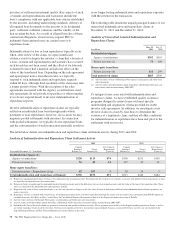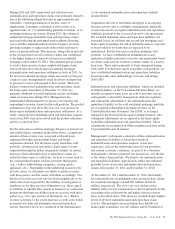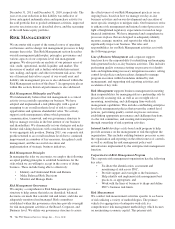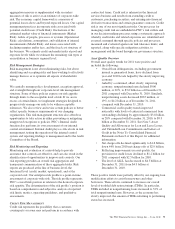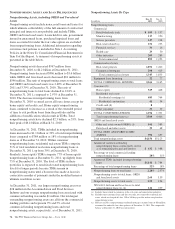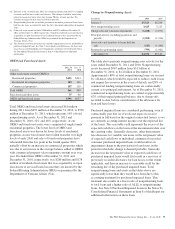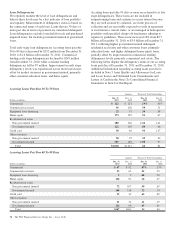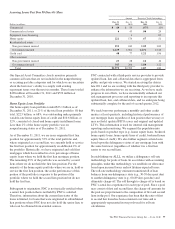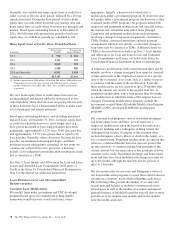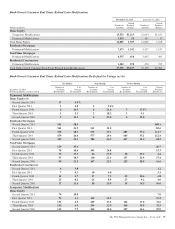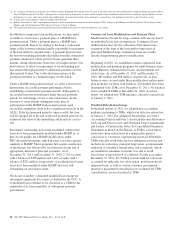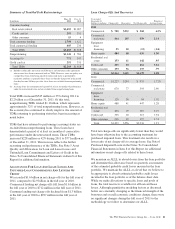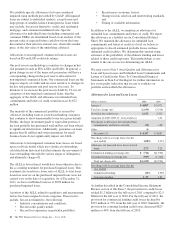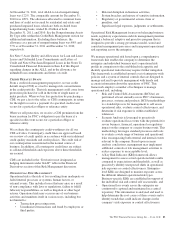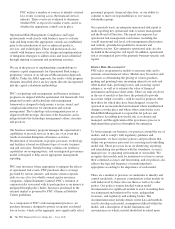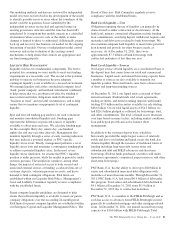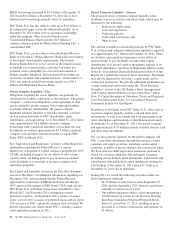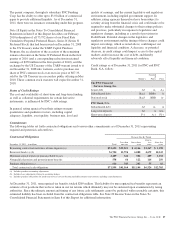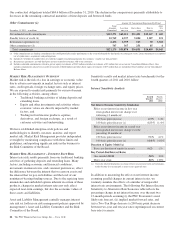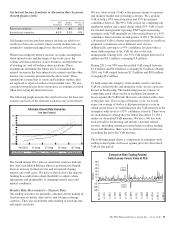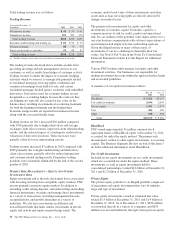PNC Bank 2011 Annual Report Download - page 89
Download and view the complete annual report
Please find page 89 of the 2011 PNC Bank annual report below. You can navigate through the pages in the report by either clicking on the pages listed below, or by using the keyword search tool below to find specific information within the annual report.(a) An account is considered in re-default if it is 60 days or more delinquent after modification. The data in this table represents loan modifications completed during the quarter ending
June 30, 2010 through June 30, 2011 and represents a vintage look at all quarterly accounts and the number of those modified accounts (for each quarterly vintage) 60 days or more
delinquent at six, nine, and twelve months after modification. Account totals include active and inactive accounts that were delinquent when they achieved inactive status.
(b) Vintage refers to the quarter in which the modification occurred.
(c) Reflects December 31, 2011 unpaid principal balances of the re-defaulted accounts for the Second Quarter 2011 Vintage at Six Months, for the First Quarter 2011 Vintage at Nine
Months, and for Fourth Quarter 2010 and prior Vintages at Twelve Months.
(d) The unpaid principal balance for permanent home equity modifications totals less than $1 million for each vintage.
In addition to temporary loan modifications, we may make
available to a borrower a payment plan or a HAMP trial
payment period. Under a payment plan or a HAMP trial
payment period, there is no change to the loan’s contractual
terms so the borrower remains legally responsible for payment
of the loan under its original terms. A payment plan involves
the borrower making payments that differ from the contractual
payment amount for a short period of time, generally three
months, during which time a borrower is brought current. Our
motivation is to allow for repayment of an outstanding past
due amount through payment of additional amounts over the
short period of time. Due to the short term nature of the
payment plan there is a minimal impact to the ALLL.
Under a HAMP trial payment period, we allow a borrower to
demonstrate successful payment performance before
establishing an alternative payment amount. Subsequent to
successful borrower performance under the trial payment
period, we will change a loan’s contractual terms. As the
borrower is often already delinquent at the time of
participation in the HAMP trial payment period, upon
successful completion, there is not a significant increase in the
ALLL. If the trial payment period is unsuccessful, the loan
will be charged off at the end of the trial payment period to its
estimated fair value of the underlying collateral less costs to
sell.
Residential conforming and certain residential construction
loans have been permanently modified under HAMP or, if
they do not qualify for a HAMP modification, under
PNC-developed programs, which in some cases may operate
similarly to HAMP. These programs first require a reduction
of the interest rate followed by an extension of term and, if
appropriate, deferral of principal payments. As of
December 31, 2011 and December 31, 2010, 2,701 accounts
with a balance of $478 million and 1,027 accounts with a
balance of $262 million, respectively, of residential real estate
loans have been modified under HAMP and were still
outstanding on our balance sheet.
We do not re-modify a defaulted modified loan except for
subsequent significant life events, as defined by the OCC. A
re-modified loan continues to be classified as a TDR for the
remainder of its term regardless of subsequent payment
performance.
Commercial Loan Modifications and Payment Plans
Modifications of terms for large commercial loans are based
on individual facts and circumstances. Commercial loan
modifications may involve reduction of the interest rate,
extension of the term of the loan and/or forgiveness of
principal. Modified large commercial loans are usually
already nonperforming prior to modification.
Beginning in 2010, we established certain commercial loan
modification and payment programs for small business loans,
Small Business Administration loans, and investment real
estate loans. As of December 31, 2011 and December 31,
2010, $81 million and $88 million, respectively, in loan
balances were covered under these modification and payment
plan programs. Of these loan balances, $24 million have been
determined to be TDRs as of December 31, 2011. No balances
were considered TDRs at December 31, 2010. As noted
below, we adopted new TDR guidance, effective retroactively
to January 1, 2011.
Troubled Debt Restructurings
In the third quarter of 2011, we adopted new accounting
guidance pertaining to TDRs, which was effective retroactive
to January 1, 2011. For additional information, see Note 1
Accounting Policies and Note 5 Asset Quality and Allowances
for Loan and Lease Losses and Unfunded Loan Commitments
and Letters of Credit in the Notes To Consolidated Financial
Statements in Item 8 of this Report. A TDR is a loan whose
terms have been restructured in a manner that grants a
concession to a borrower experiencing financial difficulties.
TDRs typically result from our loss mitigation activities and
include rate reductions, principal forgiveness, postponement/
reduction of scheduled amortization, and extensions, which
are intended to minimize economic loss and to avoid
foreclosure or repossession of collateral. For the year ended
December 31, 2011, $2.7 billion of loans held for sale, loans
accounted for under the fair value option, pooled purchased
impaired loans, as well as certain consumer government
insured or guaranteed loans which were evaluated for TDR
consideration, are not classified as TDRs.
80 The PNC Financial Services Group, Inc. – Form 10-K


